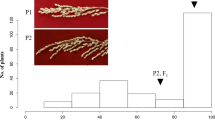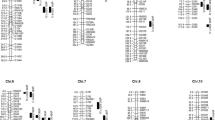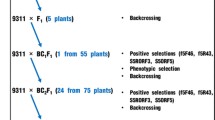Abstract
Significant segregation of spikelet fertility occurred in an F2 population derived from a spikelet fertility-normal F1 hybrid produced by a cross between ‘Palawan’, a japonica variety, and ‘IR42’, an indica variety. To identify factors controlling the fertility segregation, we used 104 RFLP markers covering all 12 rice chromosomes to investigate the association of spikelet fertility and marker segregation. We found that the segregation of two sets of gene pairs was significantly (P < 0.001) associated with fertility segregation. The first pair of genes was linked to RFLP marker RG778 on chromosome 12 and RFLP markers RG690/RG369 on chromosome 1. A significant reduction in fertility was observed when the plants were homozygote at RG778 with the indica allele as well as homozygote at RG690/RG369 with the japonica allele. The second pair of genes was linked to RG218 on chromosome 12 and RG650 on chromosome 7, respectively. The recombinant homozygote at these two loci showed a significant reduction on spikelet fertility. The non-allelic interaction effect was further modified by a gene linked to RG778, resulting in even lower fertility. The results of this study provides the first evidence of chromosomal localization of sporophytic sterility genes whose interaction can result in a reduction of spikelet fertility in the F2 derived from fertility-normal F1.
Similar content being viewed by others
References
Araki H, Ikehashi H, Toya K, Matsumoto S (1990) Development of wide compatibility rice line, ‘Norin PL 9’. JARQ 24:78–81
Causse M, Fulton TM, Cho YG, Ahn SN, Chunwongse J, Wu K, Xiao J, Yu ZH, Ronald PC, Harrington SB, Second GA, McCouch SR, Tanksley SD (1994) Saturated molecular map of the rice genome based on an inter-specific backcross population. Genetics 138:1251–1274
Cowen, NM, Johnson CN, Armstrong K, Miller M, Woosley A, Pescitelli S, Skokut S, Belmar S, Petolino JF (1992) Mapping genes conditioning in vitro androgenesis in maize using RFLP analysis. Theor Appl Genet 84:720–724
Dellaporta SL, Wood J, Hicks JB (1984) Maize DNA miniprep. In: Russell M (ed) Molecular biology of plants. A laboratory course manual. Cold Spring Harbor Laboratory Press, Cold Spring Harbor, N.Y.
Feinberg AP, Vogelstein B (1984) A technique for radio-labelling DNA restriction fragments to a high specific activity. Anal Biochem 132:6–13
Ikehashi H, Araki H (1986) Genetics of F1 sterility in remote crosses of rice. In: Rice genetics. IRRI, Manila, Phillipines, pp 119–130
Ikehashi H, Araki H (1988) Multiple alleles controlling F1 sterility in remote crosses of rice. Jpn J Breed 38:283–291
Kato S, Kosaka H, Hara S (1928) On the affinity of rice varieties as shown by the fertility of hybrid plants. Bull Sci Fac Agric Kyushu Univ 3:132–147
Kosambi DD (1944) The estimation of map distances from recombination values. Ann Eugen 12:172–175
Kumar RV, Virmani SS (1992) Wide compatibility in rice (Oryza sativa L.). Euphytica 64:71–80
Lander ES, Green P, Abrahamson J, Barlow A, Daly MJ, Lincoln SE, Newburg L (1987) MAPMAKER: an interactive computer package for constructing primary genetic linkage maps of experimental and natural populations. Genomics 74:543–552
Lin SY, Ikehashi H (1991) A gamete eliminator induced by Est 9 in chromosome 7 of rice (Oryza sativa L.). Jpn J Breed 41:350–351
Lin SY, Ikehashi J, Yanagihara S, Kawashima A (1992) Segregation distortion via male gametes in hybrids between Indica and Japonica or wide-compatibility varieties of rice (Oryza sativa L.). Theor Appl Genet 84:812–818
Morishima H, Sano Y, Oka HI (1992) Evolutionary studies in cultivated rice and its wild relatives. Oxford Surv Evol Biol 8:135–184
Nakagahra M (1972) Genetic mechanism of the distorted segregation of marker genes belonging to the eleventh linkage group in cultivated rice. Jpn J Breed 22:232–238
Oka HI (1957) Genic analysis for the sterility of hybrids between distantly related varieties of cultivated rice. J Genet 55:397–409
Oka HI (1974) Analysis of genes controlling F1 sterility in rice by the use of isogenic lines. Genetics 77:521–534
Oka HI (1978) Phylogenetic differentiation of cultivated rice, XXI. The sprophytic pollen sterility: its genetic basis and intervarietal relationships as shown by F2 sterility. Jpn J Genet 6:397–410
Oka HI (1988) Origin of cultivated rice. Jpn Sci Soc Press, Tokyo
Oka HI, Doida Y (1962) Phylogenetic differentiation of cultivated rice, XX. Analysis of the genetic basis of hybrid breakdown in rice. Jpn J Genet 1:24–35
Sano Y (1990) Genetic analysis of an alien chromosomal segment from Oryza sativa. Jpn J Breed 40[suppl 2]: 306–307
Sano Y (1993) Is an egg-killer present in rice ? Theor Appl Genet 86:1038–1042
SAS Institute (1985) SAS user guide: statistics, basic version, 5th edn. SAS Institute, Cary, N.C.
Shinjyo C (1969) Cytoplasmic-genic male sterility in cultivated rice, Oryza sativa L., II. The inheritance of male sterility. Jpn J Genet 44:149–156
Shinjyo C (1972) Distributions of male sterility inducing cytoplasms and fertility restoring genes in rice, II. Varieties introduced from sixteen countries. Jpn J Breed 22:329–333
Yanagihara S, Kato H, Ikehashi H (1992) A new locus for multiple alleles causing hybrid sterility between an Aus variety and Javanica varieties in rice (Oryza sativa L.). Jpn J Breed 42: 793–801
Zhang G, Lu Y (1993) Genetic studies of the hybrid sterility in cultivated rice (Oryza sativa L.). II. A genic model for F1 pollen sterility. Acta Genet Sinica 20:222–228
Zhang G, Lu Y, Zhang H, Yang J, Lin G (1994) Genetic studies of the hybrid sterility in cultivated rice (Oryza sativa L.). IV. Genotypes for F1 pollen sterility. Acta Genet Sinica 21:34–41
Author information
Authors and Affiliations
Additional information
Communicated by G. Wenzel
Rights and permissions
About this article
Cite this article
Wu, P., Zhang, G., Huang, N. et al. Non-allelic interaction conditioning spikelet sterility in an F2 population of indica/japonica cross in rice. Theoret. Appl. Genetics 91, 825–829 (1995). https://doi.org/10.1007/BF00223887
Received:
Accepted:
Issue Date:
DOI: https://doi.org/10.1007/BF00223887




